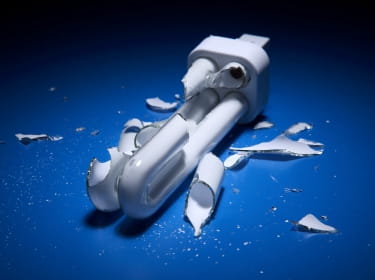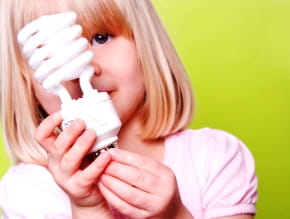Safe Cleanup Tips for Broken CFLs

The Bottom Line
Compact fluorescent light bulbs (CFLs) contain small amounts of mercury. Some of this mercury can be released into the air if the bulbs are broken. Careful cleanup of broken bulbs can minimize the risk of mercury exposure.

What are compact fluorescent light bulbs?
Compact fluorescent light bulbs (CFLs) were developed to bring the advantages of fluorescent lighting to a broad range of household settings. CFLs generate less heat than conventional incandescent bulbs, are much more energy efficient, and last longer. Incandescent bulbs have been effectively banned in the US since 2023 and were banned in Europe more than a decade earlier. Consumers are increasingly switching from CFL to LED (light-emitting diode) bulbs, which have the advantages of even longer life, instantly turning on in cold settings, dimmability, and a wider spectrum of colors.Are broken CFLs dangerous?
A CFL can contain up to about 5 milligrams (mg) of mercury. By contrast, a mercury-containing fever thermometer contained about 500 mg. Mercury can cause poisoning in some circumstances. To minimize chances of health problems, care should be taken when handling these bulbs to avoid breakage. Special steps must be taken if a bulb breaks indoors because of the risk of mercury release.How to safely clean up a broken CFL
When a CFL is broken, a small amount of mercury vapor is released immediately. The US Environmental Protection Agency maintains a detailed set of instructions for cleaning up a broken CFL. The following is a summary of its main points:
- Have everyone leave the room; avoid stepping on any of the CFL debris. Open windows and doors leading to the outside, shut off any forced air heating and cooling, and stay out of the room for 15 minutes.
- Do not use a vacuum or broom to initially clean up the debris. Scoop up what you can with a stiff piece of paper or cardboard. Try to get the rest with sticky tape or damp paper towels. Put all debris in a sealed glass jar or sealed plastic bag and take the container outside.
- It is OK to vacuum after all visible material is cleaned up, but keep the windows open and dispose of the vacuum cleaner bag afterwards in a sealed plastic bag.
- Wash your hands with soap and water.
- Check with your local government about disposal requirements in your area.
The risk to human health from individual broken CFLs is minimal, while some scientists contend that there are no real risks. Taking care when disposing of broken or unwanted bulbs is important to avoid environmental contamination.
How to safely dispose of CFLs
Some “big-box” home improvement stores offer safe disposal stations for unwanted CFLs. These are usually located near the main entrance. Alternatively, CFLs can be taken to your town’s hazardous materials collection site.Questions about a broken bulb or mercury poisoning?
For questions about mercury or the health effects of broken light bulbs, get help online with the webPOISONCONTROL tool or call 1-800-222-1222. Both options are free for the public, and available 24 hours a day.Rose Ann Gould Soloway, RN, BSN, MSEd, DABAT emerita
Clinical Toxicologist
Revised William G. Troutman, PharmD
Professor of Pharmacy Emeritus
Poison Control Media Information
Did you find this page helpful? If so, we need your support. Poison Control is in constant competition with misinformation online. Links to www.poison.org or our webPOISONCONTROL triage tool from other websites and blogs help internet searchers quickly find accurate information and Poison Control’s contact information in an emergency. If you use the content from this page, please provide attribution via a link back to this page, www.poison.org, or https://triage.webpoisoncontrol.org/#!/exclusions. By doing so, you could save a life. Thank you!
Poisoned?
CALL 1-800-222-1222
Prevention Tips
- Handle CFL bulbs carefully to prevent breakage.
- If a CFL bulb breaks, follow clean-up instructions to avoid mercury exposure.
- Dispose of unwanted CFLs properly to avoid releasing mercury into the environment.
- Replace CFLs with LED lights.
This Really Happened
A 23-month-old boy was seen by a doctor because he lost weight, had little appetite, was irritable, sweated an unusual amount, had a rash, and his fingers and toes were red and peeling. He wouldn't walk, didn't sleep well, whined, and kept wringing his hands. He also had high blood pressure. Mercury poisoning was diagnosed and treated, but his parents could not identify the source of mercury; other family members were not ill. An investigation traced the mercury to broken fluorescent light bulbs that had been stored in an area where the child played. He was discharged from the hospital to his grandmother's home, where he recovered rapidly (from Tunnessen et al., 1987).For More Information
Cleaning up a broken CFL. US Environmental Protection Agency. Updated April 13, 2024. Accessed September 21, 2024.
References
Kondro W. Mercury disposal sole health concern with fluorescent lights. CMAJ. 2007;177(2):136-137.
Poisoned?
CALL 1-800-222-1222
Prevention Tips
- Handle CFL bulbs carefully to prevent breakage.
- If a CFL bulb breaks, follow clean-up instructions to avoid mercury exposure.
- Dispose of unwanted CFLs properly to avoid releasing mercury into the environment.
- Replace CFLs with LED lights.
